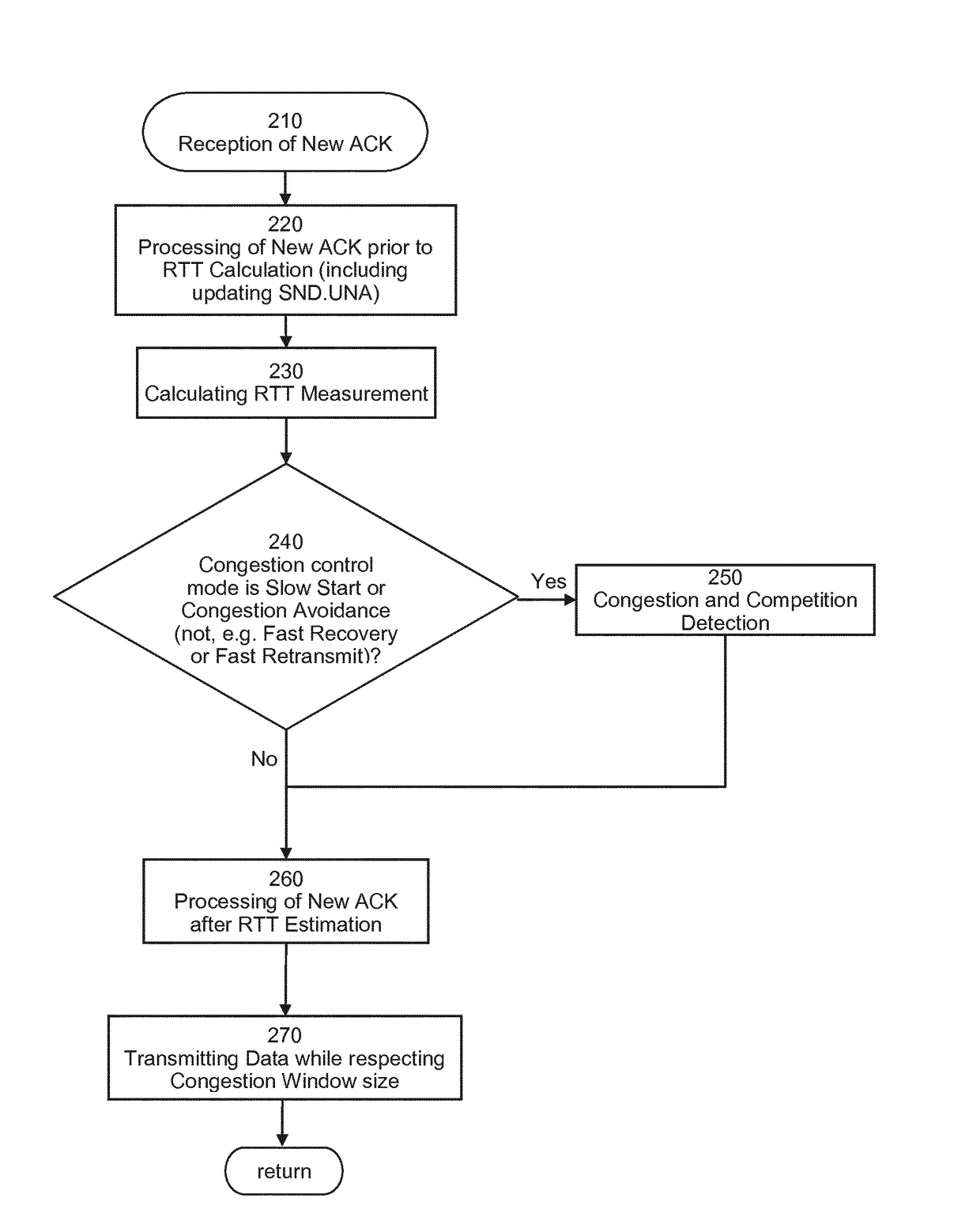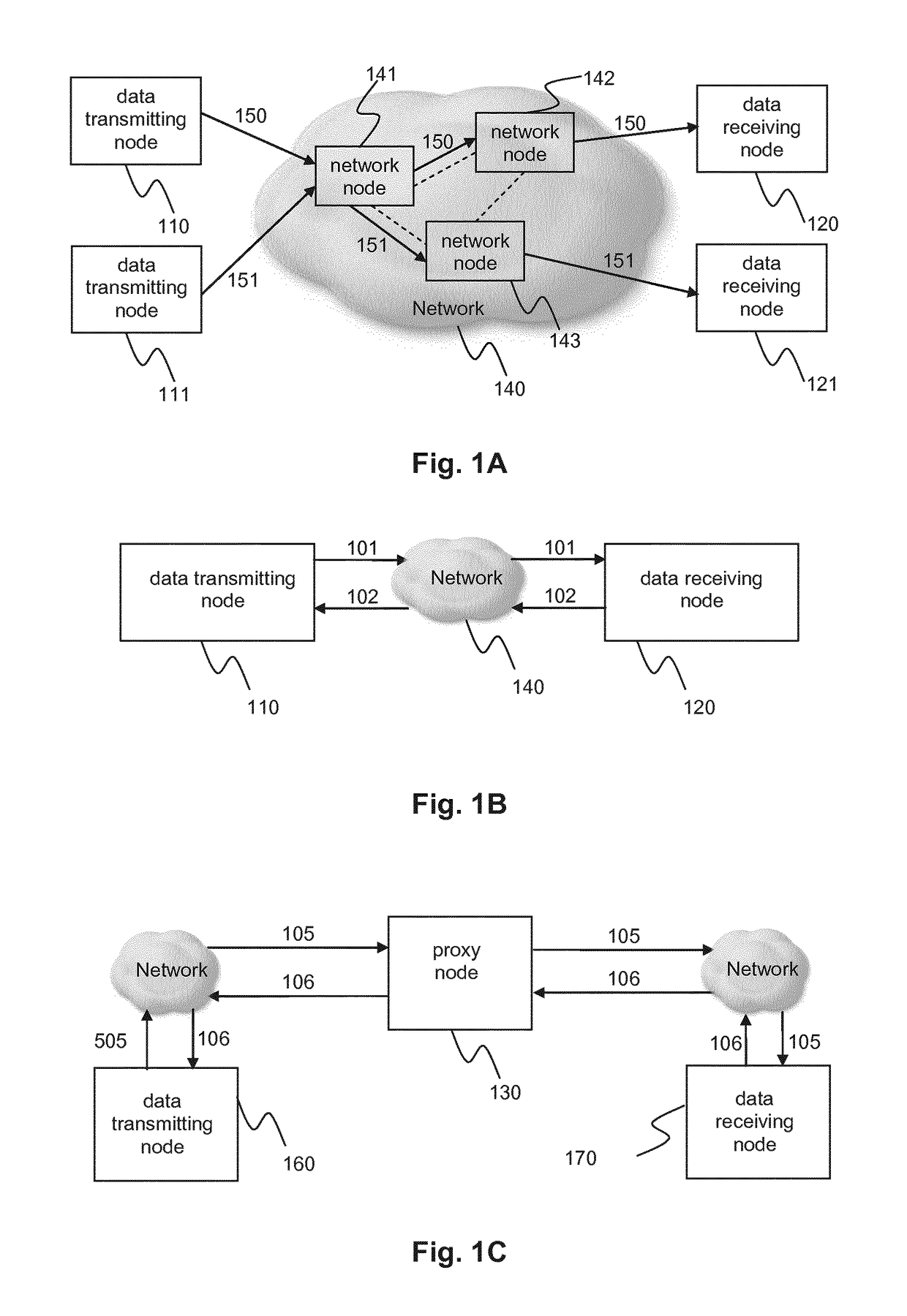Congestion situations arise in a data communications network whenever the available transmission capacity of a network node or link is lower than the
data rate it needs to
relay.
Data packets may get lost, which means that they do not arrive within a predetermined time window (i.e. time period) at the data receiving node.
Moreover, data packets may experience some
transmission errors, which may be detected at the data receiving node by standard means including error detection / correction codes such as
cyclic redundancy check (CRC) or others.
The
delay or
transmission errors may be caused by increased load within the network and / or by worsening of the channel conditions.
However, if the network experiences
high load, repeated retransmissions by many users may further worsen the situation and the network may become congested.
Even though this mechanism forces congestion to occur, it has been proved mathematically that several TCP flows sharing a
bottleneck resource and following a similar AIMD scheme for
Congestion Window growth will eventually share the available bandwidth in a fair manner.Very heavy packet losses are not recoverable with the
fast recovery procedure, which eventually causes the
retransmission timer to be triggered in the TCP sender.
This standard TCP (sometimes called Reno or NewReno), has three limitations: (1) low performance in high-speed / long-
delay networks, because the small
rate of growth of the
Congestion Window in Congestion Avoidance takes a very long time to achieve the large sizes of
Congestion Window required by those networks; (2) excessive use of network buffers (buffer-bloat), increasing the
delay experienced by the communicating hosts, due to the loss-based mechanism to detect congestion, which increases the Congestion Window up to the point where the buffers in the network nodes in the path are full and therefore sent packets get dropped, and (3) competition against concurrent TCP “greedy” flows, i.e. TCP flows that raise their Congestion Window in a more aggressive way than this standard TCP when they are sharing a bandwidth
bottleneck, which will take most of the available bandwidth for themselves and starve Reno TCP flows.
As mentioned above, performance in high-speed / long-delay networks is limited with standard TCP, because the linear Congestion Window growth in Congestion Avoidance is too slow in those cases, which results in significant unused capacity.
Such variants are in general successful at improving TCP performance in high-speed / long-delay networks, but they do not solve the buffer-bloat problems, because they use loss-based
congestion detection.
In some cases, they may also have problems sharing a bandwidth
bottleneck with less aggressive TCP variants, like standard Reno TCP, which can be overwhelmed by their more aggressive increase in Congestion Window.
However, they suffer heavily when competing against concurrent loss-based TCP variants.
Loss-based variants do not have that restraint and keep increasing their sending rate until they fill up all intermediate bottleneck buffers, resulting in less and less capacity for the delay-based flows.
Since the overwhelming majority of TCP in
the Internet today uses loss-based congestion control, this has been a major obstacle for the adoption of pure delay-based variants.
This approach can solve the buffer-bloat problems, but because of the RTT-based delay detection, like the above mentioned pure delay-based variants, it cannot compete against loss-based TCP variants.
However, in all these variants, when an RTT-based metric estimates that there is congestion, the Congestion Window will still keep growing, albeit more slowly, until packet losses arise, so buffer-bloat problems will persist, even when not competing with other data flows.
This should avoid buffer-bloat problems when there is no competition from other flows, but several unsolved Vegas problems remain, for example, low performance in high-speed / long-delay networks.
However, without adequate filtering of the
transmission rate estimates or without a statistical approach to testing the growth or stability of measured rate, the relatively large inherent variability in measured RTT spoils the
congestion detection results.
Moreover, a real-
time rate-based congestion detection is not able to distinguish between a pure congestion situation and a situation in which the TCP flow is competing against a similarly aggressive TCP flow: in both situations the window will grow and the measured rate will stay constant.
Since Tri-S reduces the Congestion Window upon congestion detection, it cannot compete against a TCP flow with loss-based congestion control, just like delay-based TCP variants.
Detecting congestion in
Slow Start only with losses may lead to severe buffer-bloat problems and packet losses, since congestion will be reached while the sending window is growing exponentially.
Some of them use measurements of inter-
acknowledgement delays, which can be inaccurate because of the time-
measurement precision and the sophisticated filtering required in the sender.
This works well except when competing against concurrent TCP flows with congestion, because the concurrent traffic will increase the RTT from the beginning, and so the switch from Slow Start to Congestion Avoidance will occur too early, which will cause a decreased
throughput.
In much of the literature, the fairness problem is about how a more aggressive (with respect to
congestion window growth) TCP variant avoids overwhelming a less aggressive one.
The problem with all these approaches is that they are very difficult to deploy, because there is an immense
installed base of routers and switches that would have to support them along the end to end path.
Summarizing, buffer-bloat remains an important problem in TCP communications, causing unnecessary delays and resource usage, because the most widely used TCP variants utilize loss-based congestion detection, which at the same time prevents the use of delay-based variants that could mitigate the buffer-bloat problem.
Almost all TCP-variants that use bandwidth-based and rate-based algorithms in determining the Congestion Window still use loss-based congestion detection, so buffer-bloat problems remain.
In the few approaches where rate-based congestion detection is used to reduce the
congestion window, measurement filtering and robust statistical methods are missing, so that the variability of measurements is not correctly addressed, and congestion is not well detected.
In fact, as long as loss-based TCP variants are used (and nowadays they are the most widely used), buffer-bloat will be inevitable for any TCP flow that has to compete with them.
Moreover, commonly-used attempts to reduce buffer-bloat in the transition from Slow-Start to Congestion Avoidance based on delay
metrics may be causing low
throughput in the face of competition from other flows.
In summary, the lack of a good mechanism for the detection of congestion and of competition is causing buffer-bloat problems in some cases and performance problems in other cases, when TCP flows do not react appropriately against competing concurrent TCP flows.
 Login to View More
Login to View More  Login to View More
Login to View More 


